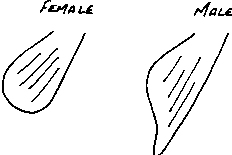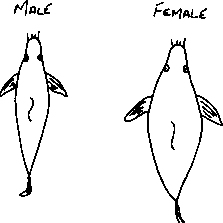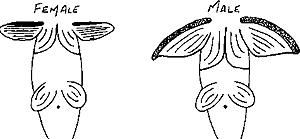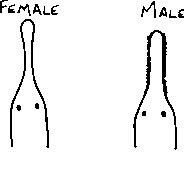Catch a tiger by the toe, If he hollers let him go, Eenie Meenie Minie Moe. Now to choose a female. Eenie Meenie Minie Moe… While this method is somewhat less than scientific, it is the most commonly used procedure in acquiring a group of catfish in which some are male and some are female. While most fishes available in stores are in the juvenile or “teenage” stage, catfish are almost always adult specimens. This is to our advantage because once mature or nearly mature, catfish show varying degrees of sexual dimorphism and the sexes can be distinguished quite easily in many cases. So let’s see what’s out there.

The most commonly kept catfishes are of the genus Corydoras and there are a great many varieties available. Since these are also the most commonly spawned catfishes, let’s start here. In much of the available literature, the authors may go as far as to say that females are larger than males or males are slimmer than females and my all-time favorite, females are fuller and stouter at spawning time. Corys are not available in stores in spawning condition so this bit of information is not particularly useful. If you have already purchased six or eight fish and conditioned them, the difference between sexes will become more noticeable but with the high cost of some corys, it would be more desirable to purchase the specific spawning group.
Some corys have such great sexual dimorphism as to make one suspect the male and female are of different species. Some that come to mind are C. barbatus, C. undulatus, and C. elegans; although there are others. In these three species, the female has the same general markings as the male but they are less distinct and less intense. In C. barbatus, the male has additional cheek bristles and a light-colored stripe running down his nose to make him look even more like another species.
Many corys show differences in fin shapes between the sexes. For example, in C. agassizii and C. wotroi, the pelvic fins of the male are longer and pointed while in the female, the pelvic fins are more paddle shaped, presumably for carrying the eggs at spawning time. See Figure 1.

Corydoras macropterus, C. paleatus, and C. steindachneri (among others) have a much longer dorsal fin on the male of the species. On some species of Corydoras, the difference in the dorsal fin of the male is not as pronounced but is evident on close inspection. Two examples are C. adolfoi and C. pygmaeus. In his book, A Fishkeeper’s Guide to South American Catfishes, Dr. David Sands reports C. trilineatus as being “Difficult to sex, but adult females are generally more robust than males.”
In fact, these are one of the easiest corys to sex in that the males have noticeable black speckles on the pelvic fins while those of the female are clear. Other corys with black speckles on the pelvic fins of the males are C. nanus and a species that I bought as the “San Juan cory”. Male C. nanus are also distinguishable from the females by a darker blotch on the dorsal fin.
Sometimes, despite out best efforts, it is difficult to pick out a definitive difference in a group of corys. When viewed from above, females are wider even when not in spawning condition. If you are on good terms with your local fish store, ask to see a group in an ice cream bucket to get a view from above. A top view will show males and females as in Figure 2. Although the difference in girth may not be as dramatic as shown, there will certainly be a size difference unless the fish are too young.
There are many other available species of Corydoras that I have not dealt with here but these common principles can be applied to any cory. Most corys have some external differences between the sexes and careful observation will detect them. Generally, males may have any of the following: more pigment on the body or fins; longer and more pointy fins; speckles on the pelvic fins, and a slimmer, more stream-lined body shape.

Some of the other commonly kept types of catfishes also show sexual dimorphism, often to a much greater extent than do Corydoras species. For instance, male catfish of the genus Callichthys and Hoplosternum have a much thicker and longer first ray on the pectoral fins. At spawning time, these thickened spines turn orange with some species. As the fish come to the surface to feed, it is also possible to see the difference in the breast plates of males and females. On males, the breast plates are larger and more overlapping while those of the female do not completely touch at the center and are much smaller. These differences are shown in Figure 3. These drawings are of Hoplosternum littorale and other species may have somewhat smaller plates for both males and females. The Farlowella, Sturisoma, and whiptail-type species show sexual dimorphism mainly, but not exclusively, in the head region of the two sexes. On male Farlowella catfish, easily visible bristles appear on the sides of the nose at spawning time. As well, the nose of the male is flatter and wider than that of the female. Figure 4 shows the nose detail of a Farlowella species. When not in spawning condition, the overall body shape can be used to determine sex. Males are generally longer, slimmer fish while females are shorter and thicker through the middle. (Picture, if you will, Clint Beaton and myself standing side by side and you will understand what I mean). When the female is in spawning condition and full of eggs, she is very thick through the middle leaving no doubt that spawning is imminent.

Sturisoma and Rineloricaria species males develop bristles in varying degrees on the cheeks, head, and pectoral fins. On some species these bristles are difficult to see unless you are looking specifically for them. Rineloricaria morrowi males are covered from head to tail in bristly fur making them look very shaggy indeed. Sturisoma males develop the bristles mainly on the cheeks and the males can be identified in this way when only 75 mm in total length (not including tail filaments). Rineloricaria and related species develop bristles on the cheeks, top of the head, and top of the pectoral fins. These bristles are not only present at spawning time, for I have three males together without a female and they all show head, cheek, and fin bristles. Rineloricaria females have the same overall body shape as males and are not particularly plump at spawning time so these are not good indicators of sexual difference. Sturisoma females get very plump at spawning time and can be easily differentiated from males which stay much slimmer.
Catfishes are not as difficult to sex as we’ve been given to believe. Knowing what to look for makes the task quite straightforward and simple. Take the test; see if the information I’ve presented enables you to determine the sex of some catfish that you keep. I’m betting that it will!
REFERENCES
The World of Catfishes by Midori Kobayagawa, TFH Publications Inc., Neptune N.J. 1991
Aquarium Atlas 2, by Hans A. Baensch, Mergus-Verlag, Germany, 1993
A Fishkeeper’s Guide to South American Catfishes by David Sands, Tetra Press 1988
Colored Atlas of Miniature Catfish by Dr. Warren E. Burgess, TFH Publications Inc. Neptune N.J. 1992
